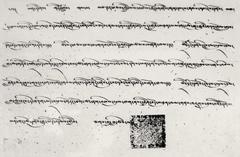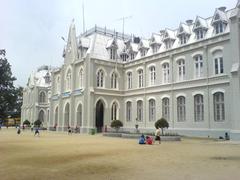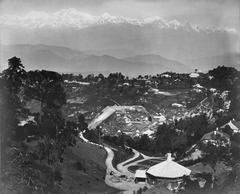Tihar Festival in Darjeeling, India: Visiting Hours, Tickets, and Cultural Significance
Date: 14/06/2025
Introduction to Tihar Festival in Darjeeling
Nestled in the Eastern Himalayas, Darjeeling is celebrated not only for its stunning natural beauty and renowned tea plantations but also for its vibrant cultural traditions. Among these, the Tihar festival stands out as a luminous event that unites communities through rituals, music, and communal festivities. Known elsewhere as Deepawali or the Festival of Lights, Tihar in Darjeeling is distinctly influenced by the town’s Nepali-speaking Gorkha population, along with the Lepchas, Bhutias, and other indigenous groups. Spanning five days, Tihar honors animals, deities, and familial bonds through a series of rituals and communal activities that embody gratitude, protection, and the triumph of light over darkness (SheThePeople; Darjeeling History Club).
Tihar is not just a religious observance—it is a living expression of cultural identity and unity. The festival is marked by traditional music, dance, and foods such as sel roti and anarsa. Homes and public spaces are adorned with oil lamps (diyas), rangoli designs, and floral decorations, and the town comes alive with Deusi-Bhailo performances, which are traditional songs and dances that promote joy and blessings throughout neighborhoods. Importantly, Tihar also emphasizes respect for nature and animals, dedicating specific days to the veneration of crows, dogs, cows, and oxen, thus reflecting Darjeeling’s agrarian roots (Holidify; TravelSetu).
For visitors, Tihar is a unique opportunity to experience the living traditions of Darjeeling in an inclusive and community-focused setting. This guide details the festival’s origins, day-wise rituals, distinctive features, and essential tips for travelers, including practical information on dates, accessibility, and local etiquette (Public Holidays Asia; Your Travel Things).
Table of Contents
- Introduction
- Historical Roots of Tihar in Darjeeling
- Cultural Significance and Symbolism
- Distinctive Features of Tihar Festival in Darjeeling
- Tihar Festival 2025: Dates and Events
- Visiting Hours and Accessibility
- Social and Communal Impact
- Modern Adaptations and Sustainability
- Tihar and Cultural Identity in Darjeeling
- Tihar Among Darjeeling’s Festivals
- Visitor Guide: Experiencing Tihar in Darjeeling
- Frequently Asked Questions (FAQ)
- Conclusion
- References
Historical Roots of Tihar in Darjeeling
Tihar’s observance in Darjeeling is rooted in the migration of Nepali-speaking communities—particularly Gorkhas, Lepchas, and Bhutias—during the 19th century, encouraged by British colonial policies. These groups brought with them customs and festivals, including Tihar, which have since been woven into Darjeeling’s multicultural fabric (SheThePeople). The festival’s enduring appeal in Darjeeling reflects the community’s commitment to preserving heritage while embracing the region’s pluralistic ethos (Your Travel Things).
Cultural Significance and Symbolism
Tihar is a multifaceted celebration of gratitude, justice, and interconnectedness. Unlike the pan-Indian Diwali, Tihar’s rituals uniquely honor animals and nature, reflecting Himalayan animistic traditions. Each day focuses on a specific theme and relationship:
- Kaag Tihar (Day 1): Crows, as messengers of Yama (god of death), are offered food to avert misfortune.
- Kukur Tihar (Day 2): Dogs are worshipped for their loyalty and are adorned with garlands and tika.
- Gai Tihar & Laxmi Puja (Day 3): Cows are venerated as symbols of prosperity, and homes are decorated to welcome Goddess Laxmi (Holidify).
- Goru Puja / Govardhan Puja (Day 4): Oxen are honored, and rituals may include Newar community Mha Puja for self-renewal.
- Bhai Tika (Day 5): Sisters apply multi-colored tika to brothers, celebrating sibling bonds and mutual protection.
These rituals emphasize respect for all living beings and the cyclical nature of life—core elements of the region’s ethos.
Distinctive Features of Tihar in Darjeeling
- Multicultural Participation: Celebrated across Nepali, Lepcha, Bhutia, and other communities, reflecting Darjeeling’s diversity (TravelSetu).
- Deusi-Bhailo Performances: Groups perform traditional music and dance, visiting homes to spread blessings—an interactive and joyful custom (Himalayan Dream Team).
- Elaborate Decorations: Streets and homes glow with oil lamps, candles, rangoli, and marigold garlands.
- Festive Foods: Traditional treats like sel roti and anarsa are prepared and shared (Peregrine Treks).
- Animal and Nature Reverence: Unique to Tihar is the veneration of animals, highlighting agrarian and animist traditions.
Tihar Festival 2025: Dates and Events
In 2025, Tihar in Darjeeling is expected from October 19th to October 23rd, aligning with the lunar calendar. Key public celebrations and Deusi-Bhailo performances often take place in the evenings, especially on Laxmi Puja and Bhai Tika days (Public Holidays Asia). For specific event schedules, consult local tourism offices or community centers.
Visiting Hours and Accessibility
- Event Times: Rituals and public festivities generally occur from 8 AM to 9 PM.
- Accessibility: Darjeeling’s hilly terrain can present challenges, but central festival areas (e.g. Chowrasta, Mall Road) are pedestrian-friendly. Taxis and local transport are available, but walking is often the best way to experience the festival atmosphere.
- Ticketing: Most events are free; cultural programs may request voluntary donations or have nominal entry fees.
Social and Communal Impact
Tihar is a catalyst for social cohesion in Darjeeling. Families reunite, communities engage in music and dance, and local youth participate in Deusi-Bhailo, raising funds for charitable projects. Schools and businesses often close or reduce hours to encourage participation (Himalayan Dream Team).
Modern Adaptations and Sustainability
Contemporary Tihar celebrations integrate electric lights, fireworks, and social media, connecting younger generations to tradition (Travers Nepal). Growing environmental awareness has led to eco-friendly practices, such as using LED lights, natural decorations, and minimizing firecracker use.
Tihar and Cultural Identity in Darjeeling
For Darjeeling’s Nepali-speaking communities, Tihar is a vital expression of linguistic, religious, and artistic heritage. Public celebrations in the town’s central squares and community halls showcase the vibrancy and pride of Nepali culture within a diverse social landscape (Your Travel Things).
Tihar Among Darjeeling’s Festivals
Tihar complements Darjeeling’s rich festival calendar, which includes Durga Puja, Losar, and Christmas. Its inclusive nature and post-monsoon timing make it a highlight of the town’s cultural year (TravelSetu).
Visitor Guide: Experiencing Tihar in Darjeeling
Tips for Visitors
- Book Early: Secure accommodation well in advance due to high demand during the festival.
- Dress Modestly: Traditional or conservative attire is recommended for visiting homes or temples.
- Respect Rituals: Ask before joining rituals or photographing ceremonies.
- Try Local Cuisine: Sample festival specialties like sel roti and achar.
- Support Local Artisans: Buy Tihar-themed handicrafts from markets.
- Be Eco-Friendly: Choose sustainable decorations and minimize firecracker use.
Getting There and Accessibility
- Access: Darjeeling is reachable by road and rail; Bagdogra is the nearest airport.
- Transport: Local taxis, shared jeeps, and walking are common during Tihar. Expect some road closures due to festivities.
Entry Fees and Ticketing
Most Tihar events are free and open to all. Some cultural programs may have tickets or request voluntary donations.
Best Places to Experience Tihar
- Chowrasta and Mall Road: Central hubs for performances and decorations.
- Local Neighborhoods: The best way to witness home-based rituals and Deusi-Bhailo.
- Temples and Monasteries: Bhutia Busty Monastery and Mahakal Temple host special prayers.
Frequently Asked Questions (FAQ)
Q: What are the Tihar festival dates in Darjeeling for 2025?
A: October 19th–23rd, 2025.
Q: Are tickets required for Tihar events?
A: Most celebrations are free; check locally for ticketed cultural performances.
Q: Can tourists participate in Tihar rituals?
A: Yes, visitors are often welcomed—always ask before joining or photographing.
Q: Where should I go to experience Tihar in Darjeeling?
A: Chowrasta, Mall Road, and local neighborhoods are epicenters of activity.
Q: Is Darjeeling accessible for elderly or disabled visitors during Tihar?
A: Some areas can be challenging due to hills and crowds; plan accordingly and seek assistance if needed.
Conclusion
Tihar in Darjeeling is a dazzling festival that goes beyond the lighting of lamps—it is an immersive cultural journey into the heart of Himalayan traditions. By participating respectfully and planning ahead, travelers can enjoy a vibrant celebration of life, gratitude, and community spirit. The festival’s open, inclusive nature and the warmth of Darjeeling’s people make it a highlight of the region’s cultural calendar.
Download the Audiala app for real-time festival updates, explore our Darjeeling Travel Guide, and follow us on social media for more cultural insights and travel tips.
Visuals and SEO Enhancement
Recommended images and alt text:
- Tihar festival decorations in Darjeeling with oil lamps and rangoli
- Deusi-Bhailo singing and dancing during Tihar in Darjeeling
- Bhai Tika ceremony during Tihar festival in Darjeeling
- Tihar festival Darjeeling lights 2025
- Bhutia Busty Monastery during Tihar
Interactive maps highlighting key festival locations and nearby historical sites are encouraged for trip planning.
References and Further Reading
- SheThePeople: Diwali Special – 5 Days Festival of Tihar
- Darjeeling History Club: The Story of Yama
- GWT: Tihar Explained
- Public Holidays Asia: Tihar Festival
- Your Travel Things: Traditional Dress and Culture of Darjeeling
- TravelSetu: Experiencing the Vibrant Festivals in Darjeeling
- Himalayan Dream Team: Tihar Festival in Nepal – Celebrating Lights, Life and Tradition
- Travers Nepal: Tihar Deepawali Festival in Nepal
- Peregrine Treks: Tihar Festival
- Holidify: Tihar Festival




